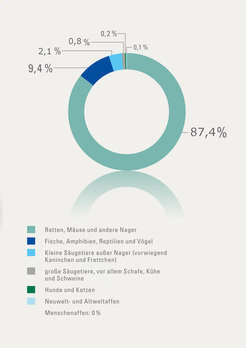Number of laboratory animals in Germany

© MPG
In 2009, almost 2.8 million animals were used for animal studies and other scientific purposes in Germany. The majority of these animals, around 87 percent, were mice and rats. Compared to rodents, dogs and monkeys are seldom used in animal tests. Cats and dogs represent 0.2 percent of all laboratory animals, and monkeys – usually rhesus monkeys – account for 0.1 percent. In Germany, there are no experiments on apes.
The number of laboratory animals used in Germany in the 1990s was successfully reduced from over 2.5 million in 1989 to below 1.5 million in 1999. The increase in the number of laboratory animals used since the year 2000 may be explained for the most part by the breeding of genetically modified animals, mainly mice. The use of these animals enables both the initial investigation and more detailed study of many diseases.
The latest data currently recorded 3,080,727 experimental animals for the year 2012 in Germany. The proportions of the individual groups of experimental animals have not changed significantly: mice and rats together still represent by far the largest group (about 87%), fish are in second (ca. 5%) and rabbits are in third place (3%). Non-human primates represent 0.05% of the laboratory animals [from: The importance of animal experiments for research, drze – Deutsches Referenzzentrum für Ethik in den Biowissenschaften].
